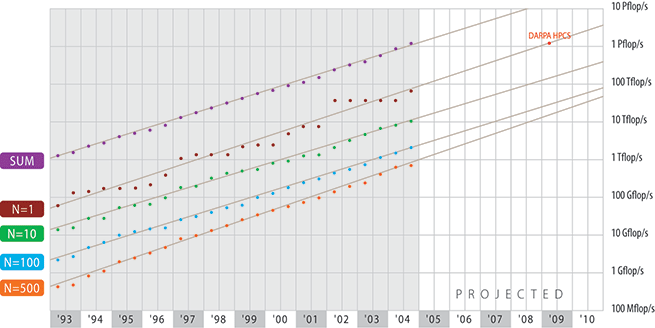Based on the current TOP500 data, which cover the last twelve years and the assumption that the current performance development continues for some time to come, we can now extrapolate the observed performance and compare these values with the goals of the mentioned government programs. In Fig. 4, we extrapolate the observed performance values using linear regression on the logarithmic scale. This means that we fit exponential growth to all levels of performance in the TOP500. This simple fitting of the data shows surprisingly consistent results. In 1999, based on a similar extrapolation,4 we expected to have the first 100 TFlop/s system by 2005. We also predicted that by 2005 no system smaller then 1 TFlop/s should be able to make the TOP500 any more. Both of these predictions are basically certain to be fulfilled next year. Looking out another five years to 2010 we expect to see the first PetaFlops system at about 20095 and our current extrapolation is still the same. This coincides with the declared goal of the DARPA HPCS program.

Looking even further into the future we could speculate that, based on the current doubling of performance every year, the first system exceeding 100 Petaflop/s should be available around or shortly after 2015. Due to the rapid changes in the technologies used in HPC systems there is however again no reasonable projection possible for the architecture of such a system in 10 years. The end of Moore's Law as we know it has often been predicted and one day it will come. New technologies, such as quantum computing that would allow us to further extend our computing capabilities are well beyond the capabilities of our simple performance projections. However, even as the HPC market has changed its face several times quite substantially since the introduction of the Cray 1 four decades ago, there is no end in sight for these rapid cycles of re-definition. And we still can say that in the High-Performance Computing market "The Only Thing Constant Is Change".
2 R. W. Hockney, C. Jesshope, Parallel Computers II: Architecture, Programming and Algorithms, Adam Hilger, Ltd., Bristol, United Kingdom, 1988.
3 H. W. Meuer, E. Strohmaier, J. J. Dongarra, and Horst D. Simon, TOP500, www.top500.org .
4 Strohmaier, 1999.
5 Strohmaier, 1999.






